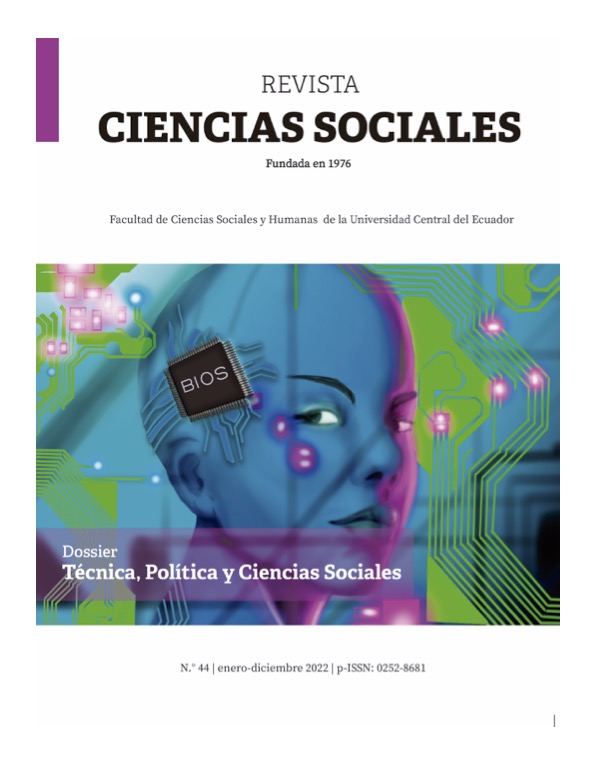The Techniques and forms of the baroque imagination and the birth of modern science
DOI:
https://doi.org/10.29166/csociales.v1i44.4135Keywords:
barroque, science, images, technique, rhetoricAbstract
The goal of this paper consists in connect the techniques and forms of the art´s symbolic production in the XVII´s century with some of the discourses and scientific progress of the same period. Following Severo Sarduy´s considerations and specially taking into account the case of Galileo, but also -although in a less way- that of Kepler and Descartes, I will follow the trail of the bonds between aesthetic attitude and scientific convictions in this thinkers in order to show the continuity of both dimensions in human existence. The presuppose is that the relation between though and expression is always dynamic and reciprocal: many ideas, theories and conceptual systems are innate with their related expressive shapes. At the same time in the variety of imaginative articulations we can find the presence and manifestation of different orders and meanings.
Downloads
References
Álvarez Gómez, J. (1995). Historia de la iglesia. Publicaciones Claretianas.
Boido, G. (1996). Noticias del planeta tierra. Galileo Galilei y la revolución científica. AZ editora.
Coffa, J.(1969). Copérnico. Centro Editor de América Latina.
Delumeau, J. (1977). La Reforma. Labor.
Galilei, G. [1610]. (2010). Sidereus Nuncius. Versión en castellano del Museo Nacional de Ciencia y Tecnología. Ministerio de Ciencia e Innovación de España. Prólogo de R. Nuñez Centella y J.M. Sánchez Ron.
Galilei, G. [1640]. (1953). Opere di Galileo Galilei
a cura di Fernando Flora. Riccardo Ricciardi Editore. En línea disponible en
https://it.wikisource.org/wiki/Lettere_(Galileo)/XXV
Kearney, H. (1970). Orígenes de la ciencia moderna (1500-1700). Guadarrama.
Koestler, A. (1981). Los Sonámbulos. Consejo Nacional de Ciencia y Tecnología de México.
Koyré, A. (1955). Actitud estética y pensamiento científico. Rev. Critique, septiembre-octubre, pp. 835-847.
Koyré, A. (1980). Estudios Galileanos. Siglo XXI.
Rioja, A. (1991). Introducción, traducción y notas a Descartes, R. El Mundo o Tratado de la Luz. Alianza Editorial.
Sarduy, S. (1987). Ensayos generales sobre el Barroco. F.C.E.
Solís Santos, C. (2001). Los cometas contra Copérnico: Brahe, Galileo y los jesuitas. Theoría, Revista de teoría, historia y fundamentos de la ciencia. Vol. 16. n° 41, 353-385.
Wittkower, R. (1939). A Counter-Project to Bernini´s “Piazza di San Pietro”. Journal of the Warburg and Courtauld Institutes. Vol.III, N°1/2 , 88-106.
Downloads
Published
How to Cite
Issue
Section
License
Copyright (c) 2023 Ángeles Smart

This work is licensed under a Creative Commons Attribution-NonCommercial-NoDerivatives 4.0 International License.
Política de acceso abierto
La revista Ciencias Sociales adhiere al modelo Acceso Abierto en el que los contenidos de las publicaciones científicas se encuentran disponibles a texto completo libre y gratuito en Internet, sin embargos temporales, y cuyos costos de producción editorial no son transferidos a los/las autores/as.
En ese sentido, no existe costo alguno para los/as autores/as en el envío o durante el proceso editorial, defendiendo el derecho a la información con equidad e iguales oportunidades de acceso.
Licencia y derechos de autor/a
Los autores conservan todos los derechos de publicación del artículo y conceden a la Revista Ciencias Sociales una licencia no exclusiva, intrasferible y sin regalías por duración ilimitada para su reproducción, distribución y comunicación pública a nivel mundial bajo una Licencia Creative Commons Atribución 4.0 Internacional (CC BY NC 4.0)


